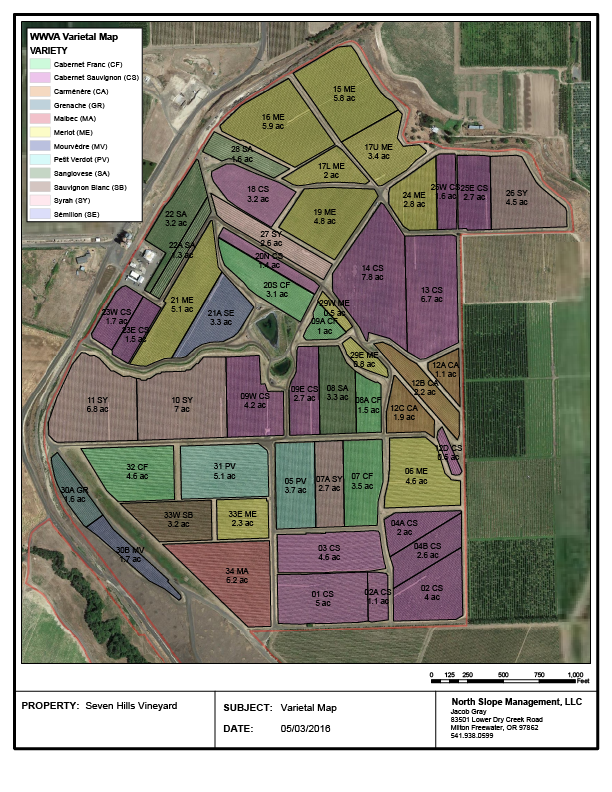
The original vineyard and heart of SeVein, Seven Hills, is one of the first commercial vineyards in the Walla Walla Valley AVA. Seven Hills Vineyard was first planted in 1980 and then expanded in 1989. Norm McKibben purchased this 20-acre old block in 1994 and, in partnership with Gary Figgins, Marty Clubb, and Bob Rupar, expanded Seven Hills Vineyard in 1997 and 1998 to over 200 acres. The three partnering wineries collectively utilize 50 percent of the vineyard fruit, selling grapes to more than 25 other premium wineries.
With an elevation of 850 to 1,050 feet, the site has excellent soil and air drainage and is one of the most technologically advanced in the industry. The vertically trained canopy, controlled cluster spacing and sunlight exposure generates uniform fruit ripeness. Soil moisture is monitored daily by computer with sophisticated drip irrigation scheduled to augment vine development yet limit excessive canopy growth. Yields are strictly controlled to assure ultra-premium quality.

The Seven Hills Vineyard sustainable viticulture philosophy is to grow high quality wine grapes with the softest approach possible. We use nature to combat nature, striving to minimize man’s control input. We are members of VINEA, a sustainable vineyard program tailored specifically to the microclimate of the Walla Walla Valley. VINEA partners with LIVE in Oregon to provide third-party sustainable certification through the European organization IOBC (International Organization for Biological Control). With a focus on soil biology and vine health, we farm using minimal inputs and earth-friendly environmental practices.
To enhance nature for biodiversity we plant wild native roses, perennial flowers, and clover for cover crop. We mow every-other row to leave enough grass in the alternate row providing food and habitat to host beneficial insects.
Soil health is directly related to quality. We observe a soft approach to the use of chemicals. Seven Hills Vineyard is continuously stimulating and inoculating for biological health in its soils with compost and compost tea.
Multiple thinning passes are made during the growing year. The amount of thinning on each pass is determined by our Quality Control director from cluster counts and weights. The last pass is made as a green harvest for even maturation.
To become more accurate and verify our method of crop size estimation, berry and cluster weights are gathered before the fruit leaves the vineyard.
We work independently with each winery to reach the target tonnage requests.
All fruit is hand-harvested for quality, to keep bins clean, and to keep the MOG (material other than grape) out. Hand harvesting allows for the fruit to be handled gently and with care.
Seven Hills Vineyard utilizes high tech moisture monitoring systems to assist in producing quality wine grapes. With only seven inches yearly of natural rainfall, the vineyard can control growth and vigor with irrigation.
Moisture monitoring sites within the vineyards continuously data log information to assist in irrigation decisions. A "Pressure Bomb" is also used to determine water potential of plant tissue.
All of the technical systems cannot replace “footprints in the vineyard” and shoot growth data is manually collected on a weekly basis from beginning of growth through cluster set. This data acts as a cross check against the high tech information.
All of these tools are vital in decision making of when and how much to irrigate but ultimately a visual and sensory evaluation is made by Sadie Drury, viticulturist. She walks the vineyard daily probing and touching the soil and noting the overall vine stress.
Irrigation is the most intensely managed aspect of growing quality wine grapes and the key is continuous monitoring throughout the year.
Our primary trellising is Vertical Shoot Positioning (VSP). We augment this by constantly running trials to test different canopies and their relationship to wine quality.
We also run continuous trials to see which trellis systems match up best with individual varietals and with different production levels